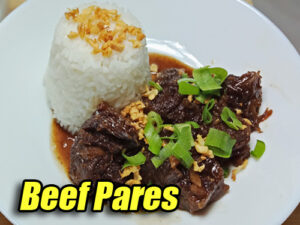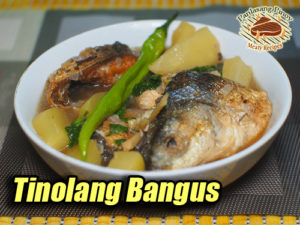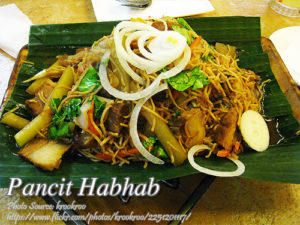It has been taken for granted that the dish Bicol express originated in Bicol and is an indigenous recipe from that region. Cely Kalaw, owner of The Grove – Luto ng Inay, the restaurant that first served this fiery concoction, is actually from Los Baños. Did you know that the reason why the dish was invented is because of the famous dish called laing?
The restaurant owners concocted this dish because many costumers were complaining that the laing they serve is too spicy but there are also some customers who wanted to eat spicy laing. So in order to solve the problem, they cut down the peppers on the laing and created Bicol express so that they can add it to the laing for customers who wants hot and spicy laing.
Bicol Express: A Fiery Dish with a Surprising History
When I first heard about Bicol express as a child, I assumed it was just another classic dish hailing from the vibrant province of Bicol. My mom always joked that it was a dish so spicy it could “send you straight to Bicol in a single bite!” But as it turns out, this creamy, spicy stew has a history as rich as its flavors, and its roots aren’t entirely what you might expect.
A Los Baños Original Inspired by Bicol’s Heat
Bicol Express might carry the name of the province, but did you know it was created in Los Baños? The brilliant mind behind this dish is none other than Cely Kalaw, the owner of The Grove – Luto ng Inay, a humble restaurant that served a variety of Filipino comfort food. Her inspiration? A common dilemma with another beloved dish: laing.
Laing, the famous taro leaf and coconut milk concoction, is traditionally very spicy. However, not all diners could handle its heat, while others couldn’t get enough of it. So what did Cely do? She whipped up the spicy dish, a pork stew simmered in coconut milk, spiked with just the right amount of chili, and seasoned with shrimp paste. This clever innovation allowed diners to customize their laing experience, adding the spicy dish to their plate if they craved a fiery kick.
To this day, this dish is celebrated not just for its bold flavors but also for its ingenious solution to a culinary conundrum.
Memories of the First Bite
I still remember the first time I tasted this dish. It was during a family reunion at my Tita Mely’s house in Laguna. She told us the story of Bicol Express while simmering the pot of creamy goodness on her stovetop. The smell of pork and garlic melding with coconut milk and shrimp paste filled her kitchen, making us all impatient for dinner.
My cousin, Lito, who was fresh from a trip to Naga, teased that this version would never pass in Bicol because it wasn’t spicy enough. Still, when Tita served it with hot, steaming rice, no one could complain. The blend of savory, creamy, and spicy flavors hit the spot, warming us from the inside out.
Cooking Bicol Express at Home
Making the dish at home is simpler than it seems. I’ve learned a few tricks over the years, some passed down by my relatives and others I’ve picked up on my own.
First, don’t skip the step of removing the seeds from the chilies if you’re not a fan of extreme heat. My brother, Jun, once left the seeds in, and it turned our family dinner into a contest of who could keep eating without tears streaming down their face! By slicing the chilies lengthwise and discarding the seeds, you can control the spice level without losing the dish’s signature kick.
Simmering the pork with garlic and onions in coconut milk is what gives Bicol express its silky richness. This step allows the flavors to blend harmoniously while tenderizing the meat. My uncle Ernesto, who worked as a cook in a small carinderia, always said that letting the dish cook low and slow is the key to achieving the perfect consistency. And he was right; rushing it will only result in a sauce that’s either too runny or too oily.
When adding the shrimp paste, start with a small amount and taste as you go. This ingredient adds that distinct salty, umami flavor, but too much can overpower the dish.
The Legacy of Bicol Express
It isn’t just a dish—it’s a testament to Filipino ingenuity and adaptability. It represents how we Filipinos find creative solutions to challenges, even in the kitchen.
Despite its origins in Los Baños, it is deeply tied to Bicol’s culinary identity because of its generous use of chilies and coconut milk, ingredients that are staples in the region. It’s a dish that bridges cultures and tells a story with every spoonful.
Food historians also point out that the name “Bicol express” might have been inspired by the famous train route connecting Manila to Bicol. Just like the train, the dish delivers a powerful punch that’ll leave you breathless yet satisfied.
Bringing the Taste of Bicol to Your Table
Cooking the dish is more than just following a recipe—it’s about connecting to the vibrant flavors of Filipino cuisine and the stories behind them. Whether you’re a fan of fiery dishes or prefer a milder version, this dish is sure to make a lasting impression on your taste buds.
Every time I make it, I think of the laughter at Tita Mely’s dining table, the stories of Uncle Ernesto, and my cousin Lito’s dramatic reactions to chili seeds. It’s more than just a meal; it’s a slice of home, a bowl of memories, and a celebration of the Filipino spirit.
So the next time you’re craving something comforting with a bit of a kick, why not give this dish a try? It’s a dish that’s as easy to make as it is to love—perfect for both beginners and seasoned cooks. After all, it’s not just food; it’s a flavorful journey worth savoring.
How to Cook Bicol Express
Ingredients
- 1/4 kilo green long chili siling pang-sigang
- 1/2 cup pork sliced in strips
- 3 cloves garlic crushed
- 1 pc medium onion chopped
- 2 cups thick coconut milk
- 2 tsp. bagoong or shrimp paste
Instructions
How to Cook Bicol Express:
- Remove stems from the green chilies and cut lengthwise to remove seeds. Slice into 1/2 inch pieces.
- In a casserole combine the pork, garlic, onion and coconut milk.
- Bring to a boil, lower the heat and simmer until pork is tender.
- Add the sliced chilies and continue cooking until chilies are soft and sauce is thickened.
- Add shrimp paste to taste.
Notes
Cooking Tips:
Control the Heat by Adjusting the Chilies
To customize the spice level of your dish, remove the seeds and inner membranes of the chilies before slicing. This reduces the intensity of the heat while keeping the distinct flavor of the peppers. If you love extra spice, leave some seeds in or add more chilies, but be mindful that too much heat can overpower the creamy coconut base.Simmer the Pork Low and Slow
Cooking the pork gently over low heat allows it to become tender while soaking up the rich flavors of coconut milk, garlic, and onions. Rushing this process can leave the meat tough and the sauce underdeveloped. Letting it simmer also thickens the sauce naturally, creating the perfect consistency for every bite.Add Shrimp Paste Gradually
Shrimp paste is essential for the distinct umami taste of this iconic dish, but its strong flavor requires careful balancing. Start with a small amount, taste, and adjust as needed to avoid overwhelming the dish. Mixing it in gradually ensures you get the savory depth without overpowering the creamy and spicy flavors.






I really miss Filipino food especially Bicol Express. How I wish I can have a vacation every 3 months and spend time with my friends and family.
Bicol express is actually indigenous to the Bicol region. It was not Cecilia Kalaw who first served the concoction. Bicol express or “gulay na sili” which was what it was originally called was introduced in Manila by my father, Demetrio Kalaw. He married my mother, Milagros Estrada, who is from Iriga City, Camarines Sur. Demetrio lived in Iriga City during the early years of their marriage. He was then introduced to the Bicol dishes at that time . You see, in the Bicol region, when you say “gulay”, that indicates that the dish has coconut milk . Cooking with coconut milk and “sili” are very popular in the region. My parents first opened a small restaurant in Malate . Later on , they opened “The Grove” in Ermita, a large buffet style restaurant with numerous Filipino dishes , including Bicol express, Laing etc. The Grove was actually quite successful in the early 1970’s. Clientele included the Marcoses, celebrities, tourists.
Bicol express got its name from the train that would travel from Manila to Bicol
In those days before air conditioned buses were in existence .
Thanks for that great info about the history of bicol express Ms Solita. That was an eye opener.